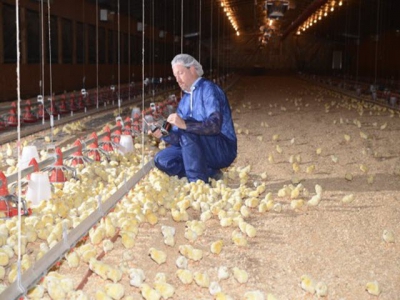How to tell if chicks are getting what they need

Brooding plays an essential role in laying the foundation for optimal flock performance. Without proper brooding, chicks can’t reach their genetic potential, resulting in reduced yield, poor flock uniformity, and higher mortality rates.
Checking house and litter moisture helps assess litter management in between flocks, ventilation practices, and water line management. Photo: Cobb
Capitalising on this time period is critical as poor performance during brooding cannot be compensated for later on. Checking to see if your chicks are getting what they need to grow and thrive helps maximise results during brooding, setting yourself up for a successful and profitable flock. Below you will find a few items that provide us measurable indicators of how well we are doing with the management of our flocks.
Rectal temperature
One way to determine if your chicks are warm enough is to take their rectal temperature. A chick’s rectal temperature should be measured coming off the delivery truck and again within the first couple of hours post-placement. A temperature of 104-104.5° F (40-40.27° C) is considered normal. Anything above or below that can be detrimental to a chick’s health and progress.
Be on the lookout for indicators of heat or cold stress during the first three to four days after placement. These indicators can include, but are not limited to, reduced food and water intake, huddling together as if cold, crowding the walls signalling overheating, and lethargic behaviour.
Crop checks
Another way to determine whether or not your chicks are getting what they need is to check their crops within the first 12-24 hours after placement. To check a crop, physically pick up the chick and feel the crop to see if it is filled with a feed/water mixture. A properly filled crop will have a peanut butter-like consistency.
If less than 95% of the chicks you check have full crops, check the following factors:
- Feed – not enough feed, feed surface area, physical form of feed, feed quality
- Water – quality, quantity, drinker lines too high/low, drinker nipples stuck, incorrect pressure, temperature too warm
- Ventilation – under ventilation (high CO2, ammonia, humidity), overventilation (air drafts, excessive heater run time causing hot spots under them, huddling of birds), air leaks at chick level, improper air administration
- Temperature – too warm (driving chicks away from feed), too cool (chicks holding close to heat)
Day 0, 7, and 14-day weights
Taking 0, 7, and 14-day weights can help determine if your chicks are gaining weight at an appropriate rate. Seven days after placement, a chick’s weight should be 4.39 times their weight at placement, while at 14 days after placement their weight should increase 2.51 times their 7-day weight. If your chicks are not gaining enough weight, you may want to re-evaluate your management practices.
House and litter moisture
Checking house and litter moisture helps assess litter management in between flocks, ventilation practices, and water line management. An appropriate level of moisture in the house is approximately 60%, while an appropriate level of moisture for litter is around 25-30%. Too much moisture can result in foot pad lesions, causing reduced food/water intake and growth, increasing bacterial infection and the probability of disease, elevated condemnation at processing, as well as reduced paw quality and harvest percentages.
In order to measure moisture levels, you will need a relative humidity (RH) meter. You can also do a ‘hand grasp’ test to determine litter moisture in which you grab a handful of litter; if it falls apart and crumbles in your hand, the level of moisture is adequate. However, if the litter sticks together forming a ball-like structure, the moisture level of the litter is too high.
Continuously measure performance
Many in our industry take a ‘wait to see where the birds settle’ at the end of the grow out to determine the performance of the flock. The problem with this approach is we don’t know at what point the lack of performance occurred; therefore, it is advisable to measure performance throughout the life of a flock, especially during brooding.
Taking these measurements not only makes it possible to track progress but it also allows you to make the necessary tweaks in your management practices, helping to keep your flock on the right track to optimal performance.
Có thể bạn quan tâm
 3 feed tips for managing antibiotic-free animal production
3 feed tips for managing antibiotic-free animal production Antibiotic-free animal production requires efforts on multiple fronts
 Holistic approach to feeding heat-stressed broilers
Holistic approach to feeding heat-stressed broilers A quick guide to help adjust feeding programs for broilers to withstand summer heat stress.
 Resistant bacteria in intestinal tract linked to antibiotic usage
Resistant bacteria in intestinal tract linked to antibiotic usage Levels of antibiotic resistance in the intestinal tracts of broilers and pigs are linked to antibiotic usage, according to the results of a pan-European study.